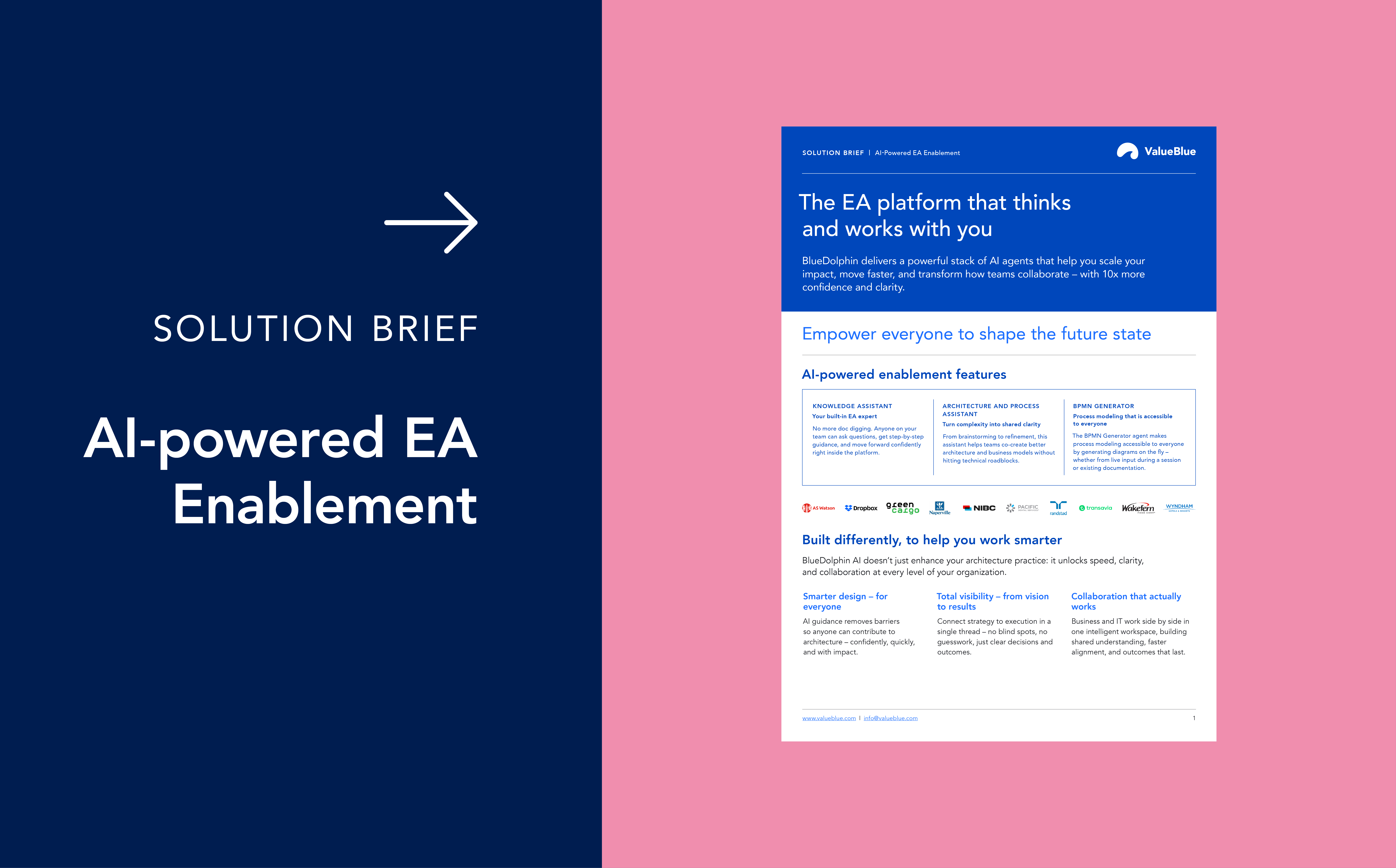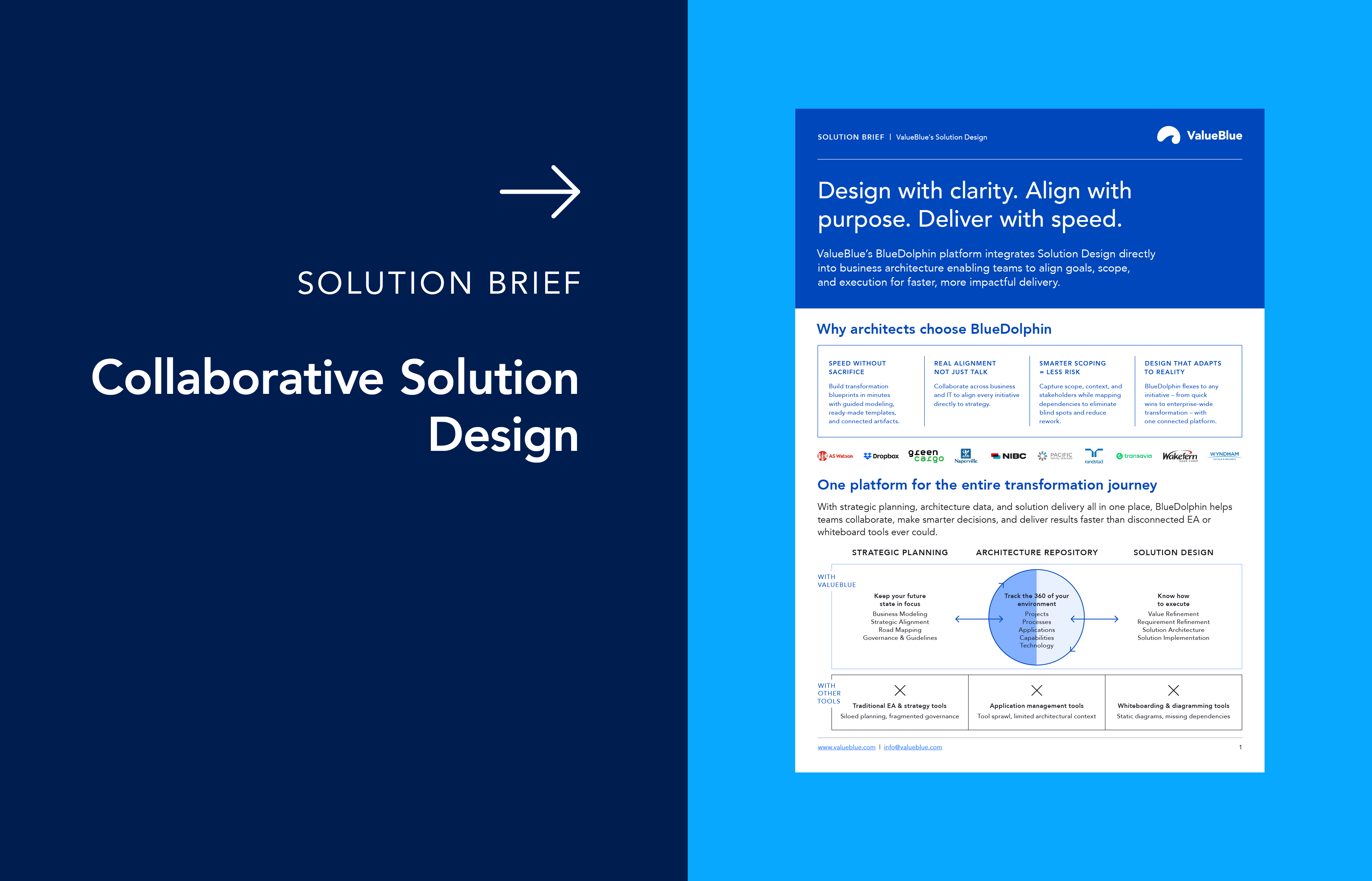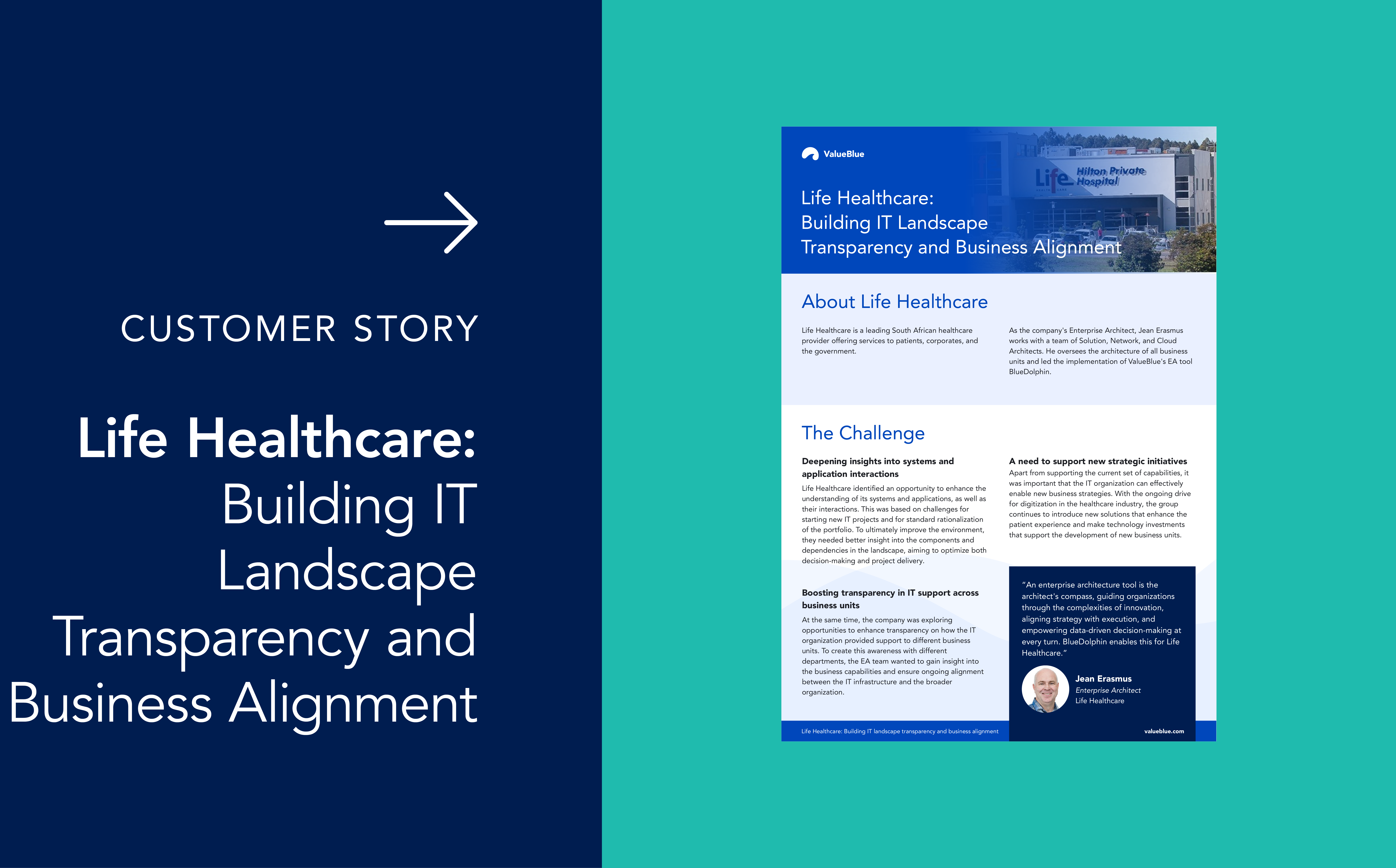Modernising Outdated Applications with the Solution Design Approach
As technology evolves, many organizations find themselves relying on outdated applications that are costly to maintain, difficult to scale, and increasingly vulnerable to security threats. Upgrading or replacing these legacy systems can be a major undertaking that requires clear objectives, structured collaboration across teams, and a well-defined approach.
In this blog, we examine how ValueBlue’s BlueDolphin Solution Design approach supports successful modernization efforts, specifically for the “upgrading or replacing outdated applications” use case. By following the core phases of Value Refinement, Requirements Refinement, Solution Architecture Design, and Solution Implementation, organizations can ensure a seamless transition to modern, efficient, and future-proof solutions.
Understanding the BlueDolphin Solution Design Approach
ValueBlue’s Solution Design Approach provides a structured and value-driven method for modernizing applications. The approach is made up of four essential phases:
- Value Refinement
- Requirements Refinement
- Solution Architecture Design
- Solution Implementation Design
This systematic process ensures that every modernization initiative addresses genuine business needs, prioritizes stakeholder alignment, and delivers measurable outcomes.
1. Value Refinement: Establishing the “why”
When planning to upgrade or replace outdated applications, it’s critical to start by clarifying the strategic and financial rationale behind modernization.
Key activities and considerations
- Identify business drivers: Determine the primary objectives, such as cost savings, risk reduction, performance gains, regulatory compliance, or innovation.
- Align with business strategy: Ensure modernization efforts support broader initiatives such as cloud adoption, digital transformation, or improving the user experience. This ties in neatly with Capability-Based Planning, providing the optimal opportunity to refresh or enhance capability maturity levels to support the delivery of initiatives.
- Conduct stakeholder alignment: Engage leadership, IT, and relevant business units. Their early buy-in ensures the project meets varied needs and secures resource commitments.
- Define success criteria: Concrete metrics for success might include lower maintenance costs, reduced downtime, improved response times, or enhanced customer satisfaction.
Key deliverables
1. Business case and justification
Documented within BlueDolphin’s project templates, plus any object type questionnaire(s) for clarity on scope and expected outcomes.
2. Value Proposition Canvas (VPC)
Ensures the solution truly aligns with customer and stakeholder needs by identifying pain points and value drivers.
Visualises end-to-end service processes, highlighting interactions between customers, staff, and back-end systems that might be impacted by modernization.
The Value Refinement phase ensures that everyone agrees on the necessity of the upgrade or replacement and the benefits it will yield.
2. Requirements Refinement: Defining the “what”
With the initiative’s value and objectives clear, the next phase focuses on capturing and detailing the functional and technical requirements for the modernized solution.
Key activities and considerations
- Engage stakeholders: Collaborate closely with end-users, IT teams, and business owners to gather comprehensive requirements.
- Review existing workflows and pain points: Evaluate inefficiencies or problems in the legacy application to guide redesign priorities.
- Define functional and non-functional requirements: Specify capabilities (e.g., forms, data processing, integrations) and performance constraints (such as availability, security, and scalability).
- Identify dependencies and integrations: Determine how the modernized application will interface with other enterprise systems, such as ERP, CRM, or data warehouses.
Key deliverables
1. High-Level Design (HLD)
An overview of system components and interactions without detailed technical specs.
2. Solution Requirements
A refined list of functional and technical requirements captured as Solution Requirements in BlueDolphin or associated with relevant repository objects.
This phase eliminates confusion and scope creep by clearly documenting the new system’s required functionalities and expected outcomes.
3. Solution Architecture Design: Shaping the “how”
Once the requirements are refined, the focus shifts to the technical architecture – how the modernized application will be designed and how it will operate.
Key activities and considerations
- Assess current-state architecture: Inventory existing applications, data, and infrastructure to determine the best modernization approach (e.g., re-platform, refactor).
- Define future-state architecture: Choose between cloud-based, micro-services, or API-driven models, depending on organizational goals for scalability and agility.
- Select the technology stack: Identify preferred cloud providers, databases, frameworks, and security tools.
- Plan a migration strategy: Options might include:
- Re-host (Lift and Shift)
- Re-platform (Partial Modernization)
- Refactor (Full Re-architecture)
- Retire/Replace (Decommission and implement new solutions)
Key deliverables
1. Solution Sketch
A high-level, visual representation of the proposed architecture, captured as a Solution Sketch view in BlueDolphin.
2. Process Flow Design
A detailed map of each business or technical process, showing interactions and decision points.
3. Application Integration Design
Specifies how various software systems will connect and communicate, ensuring data consistency across the enterprise.
4. Technology Design
Outlines the selected platforms, frameworks, and services, establishing a solid foundation for implementation.
In this phase, organizations establish how to best leverage modern technologies to replace or enhance outdated applications, ensuring the architecture aligns with strategic business objectives.
4. Solution Implementation Design: Executing the plan
With a clear blueprint in place, it’s time to implement the upgraded or replaced application – and ensure minimal disruption to the business.
Key activities and considerations
- Work package breakdown: Utilize agile tools (Jira, Azure DevOps) to create actionable tasks based on the architecture.
- Deployment strategy: Plan phased rollouts or pilot testing to manage risk, supported by Continuous Integration/Continuous Delivery (CI/CD) pipelines.
- Data migration: Outline ETL processes validation steps and perform rigorous testing before and after data moves.
- Minimize disruptions: Develop rollback strategies for any unforeseen issues, keeping downtime and potential losses to a minimum.
- Monitor and measure success: Track key performance indicators (KPIs) related to cost, performance, and user satisfaction to determine if the modernization meets the defined objectives.
Key deliverables
1. Implementation Roadmap
A timeline of project milestones and resource allocations, documented in BlueDolphin or linked to external project management tools.
2. Detailed deployment and migration strategy
Outlines how the transition from the legacy environment to the modern solution will be planned, tested, and executed.
3. Monitoring dashboard
A centralized BlueDolphin dashboard (or integrated monitoring tools) to quickly identify and address issues, ensuring post-migration stability.
Through disciplined implementation, organizations can confidently go live with the new or upgraded application, maintaining transparency and fostering stakeholder engagement.
Begin your modernization journey today!
Modernizing outdated applications is often a complex endeavor, but ValueBlue’s BlueDolphin Solution Design approach brings clarity, alignment, and structure to the entire process. By refining your initiative’s value, defining precise requirements, designing the ideal solution architecture, and methodically implementing changes, your organization minimizes risks and maximizes the return on modernization investments.
If you’re looking to upgrade or replace legacy applications, consider adopting this systematic approach. With the right strategy, stakeholder buy-in, and technical blueprint, you can transform your IT landscape into a scalable, secure, and future-ready environment that drives tangible business value.
Ready to begin your modernization journey? Contact us to discover how BlueDolphin can streamline your application modernization initiatives and help you achieve your digital transformation objectives.




